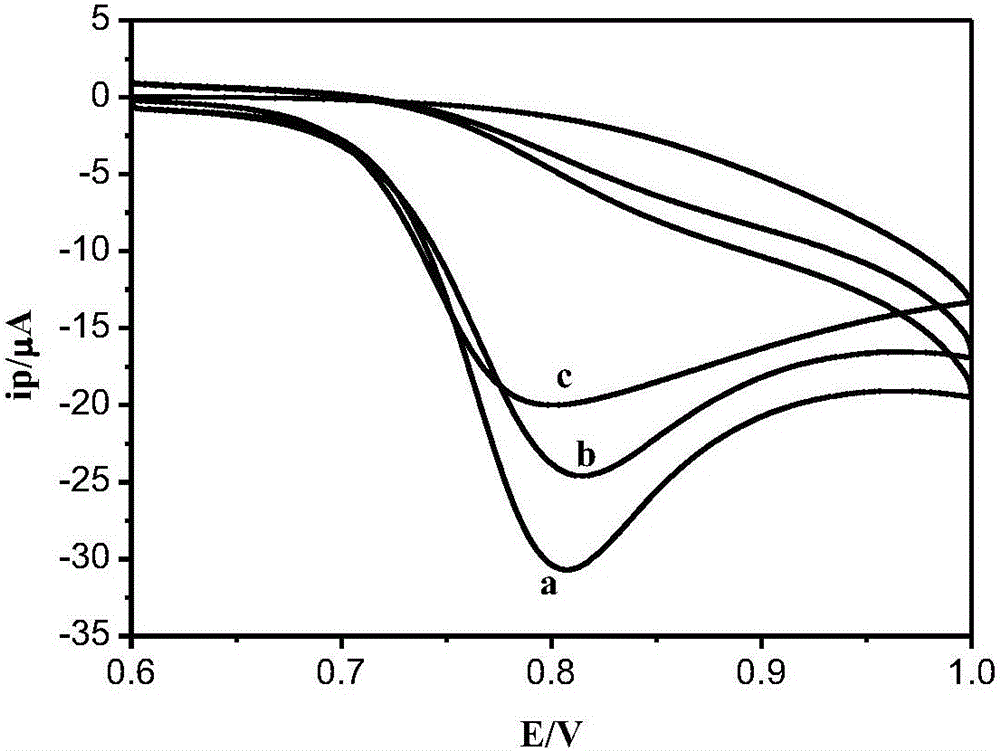Method for detecting o-chlorophenol based on PEDOT/g-C3N4 electrode
A technology of o-chlorophenol and g-c3n4, applied in the field of electrochemical detection, can solve the problems of cumbersome operation and high cost, and achieve good reproducibility and good anti-interference effect
- Summary
- Abstract
- Description
- Claims
- Application Information
AI Technical Summary
Problems solved by technology
Method used
Image
Examples
Embodiment 1
[0025] (1) g-C 3 N 4 Electrode preparation:
[0026] The glassy carbon electrode (GCE) was sequentially filled with 0.3 and 0.05 μm α-A1 2 o 3 Polish to a mirror surface, then use absolute ethanol and double-distilled water to sonicate for 5 minutes, and finally rinse with double-distilled water and dry at room temperature; take 5 μL of g-C with a concentration of 500 μg / mL 3 N 4 After the aqueous solution was ultrasonically cleaned, it was dropped onto the surface of the GCE and dried at room temperature.
[0027] (2) PEDOT / g-C 3 N 4 Electrode preparation:
[0028] Construct a three-electrode system, that is, g-C 3 N 4The modified electrode was used as the working electrode, the saturated calomel electrode was used as the reference electrode, and the Pt wire electrode was used as the counter electrode, with 10 mL of pure aqueous solution of 0.0142 g EDOT monomer and 0.208 g PSS as the electrolyte (0.01 mol L -1 EDOT and 0.1mol L -1 PSS), deposited on GCE at a const...
Embodiment 2
[0030] The glassy carbon electrode (GCE) was sequentially filled with 0.3 and 0.05 μm α-A1 2 o 3 Polish until it becomes a mirror surface, then use absolute ethanol and double distilled water to sonicate for 5 minutes, and finally rinse with double distilled water and dry at room temperature; build a three-electrode system, that is, use a glassy carbon electrode as a working electrode and a saturated calomel electrode Used as a reference electrode and a Pt wire electrode as a counter electrode, with 0.01mol L -1 EDOT monomer and 0.1mol L -1 10mL of pure aqueous solution of PSS was used as the electrolyte, which was deposited on the GCE at a constant potential of 0.8V and a scan time of 400s to obtain a PEDOT electrode.
Embodiment 3
[0032] Using cyclic voltammetry (CV) for glassy carbon electrode, PEDOT electrode, PEDOT / g-C 3 N 4 Electrode performance testing; the electrolyte is a mixed solution of ABS buffer solution with pH=4.5 and o-chlorophenol, the control potential scanning range is 0.6-1.0V, and the scanning speed is 0.1V / s. Cyclic voltammetry (CV) characterization results are attached figure 1 shown.
[0033] Compared with the glassy carbon electrode, the peak current of o-chlorophenol on the PEDOT electrode is significantly enhanced because of the excellent conductivity of PEDOT. Compared with PEDOT electrode, PEDOT / g-C 3 N 4 The electrode exhibited higher sensitivity to o-chlorophenol due to the g-C 3 N 4 It can effectively increase the specific surface area of the electrode, and is conducive to the adsorption of o-chlorophenol on the electrode.
[0034] Using cyclic voltammetry (CV) for glassy carbon electrode, PEDOT electrode, PEDOT / g-C 3 N 4 Electrode performance test; the electrol...
PUM
 Login to View More
Login to View More Abstract
Description
Claims
Application Information
 Login to View More
Login to View More - R&D
- Intellectual Property
- Life Sciences
- Materials
- Tech Scout
- Unparalleled Data Quality
- Higher Quality Content
- 60% Fewer Hallucinations
Browse by: Latest US Patents, China's latest patents, Technical Efficacy Thesaurus, Application Domain, Technology Topic, Popular Technical Reports.
© 2025 PatSnap. All rights reserved.Legal|Privacy policy|Modern Slavery Act Transparency Statement|Sitemap|About US| Contact US: help@patsnap.com



